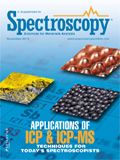Detecting Metals in the Brain with LA–ICP-MS
Spectroscopy recently spoke with Dominic Hare, a senior research officer at the Florey Institute of Neuroscience and Mental Health in Australia, about his work using laser ablation–inductively coupled plasma–mass spectrometry (LA–ICP-MS) to study metals in the brain.
Spectroscopy recently spoke with Dominic Hare, a senior research officer at the Florey Institute of Neuroscience and Mental Health in Australia, about his work using laser ablation–inductively coupled plasma–mass spectrometry (LA–ICP-MS) to study metals in the brain.
At ASMS this year you presented research on the role of high levels of iron and dopamine in Parkinson's disease, specifically the chronic degeneration of neurons in the substantia nigra pas compacta region of the brain. Why did you decide to use LA–ICP-MS in your research?
ICP-MS is unrivaled in terms of sensitivity, so it was the logical choice for studying trace metals in the brain, and the precise optics and micrometer-scale measurement capacity of the systems make it an ideal tool for imaging metals, approaching the cellular level of detail.
What are the implications of your research?
Parkinson's disease is the second most common neurodegenerative disorder (after Alzheimer's), yet we know relatively little about how and why this disease occurs. More and more evidence is pointing toward mishandling of metals in dopamine-producing neurons, which produces a unique chemical reactivity toxic to the cell. By identifying the deficits in metal metabolism, we uncover new clues about why Parkinson's disease occurs, and how we might be able to intervene therapeutically.
Your current research is on studying new techniques for imaging metals in single brain cells. What discoveries have you made so far?
For some time, most of my work focused on technical aspects of LA–ICP-MS analysis: how to improve image quality, how to image smaller areas, how to represent metals in the brain in three dimensions, and whatnot. Now, I'm working much more closely with neuroscientists to answer specific biological questions. We're currently finding exciting new features of the healthy brain that give clues as to why only a very specific region of the brain is affected. We think that the very nature of iron in the brain as a mediator of many chemical reactions might also contribute to neurotoxicity in Parkinson's.
What are the next steps in your work?
The next step is to examine how iron changes in the human brain of Parkinson's sufferers. The immense variability and environmental factors influencing iron levels in the brain presents another significant challenge to deducing the role of this essential element.

High-Speed Laser MS for Precise, Prep-Free Environmental Particle Tracking
April 21st 2025Scientists at Oak Ridge National Laboratory have demonstrated that a fast, laser-based mass spectrometry method—LA-ICP-TOF-MS—can accurately detect and identify airborne environmental particles, including toxic metal particles like ruthenium, without the need for complex sample preparation. The work offers a breakthrough in rapid, high-resolution analysis of environmental pollutants.
Trending on Spectroscopy: The Top Content of 2024
December 30th 2024In 2024, we launched multiple content series, covered major conferences, presented two awards, and continued our monthly Analytically Speaking episodes. Below, you'll find a selection of the most popular content from Spectroscopy over the past year.